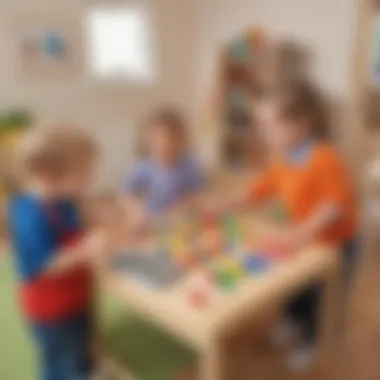Engaging Sound Games for Preschool Development


Intro
Sound is all around us, playing a vital role in our daily lives. For preschoolers, engaging with sound can be a thrilling adventure. It helps them make sense of the world and develop essential skills along the way. As they explore the various sounds in their environment, they sharpen their auditory skills, boost cognitive growth, and foster social interactions.
Sound games provide an engaging way to dive into this auditory exploration. From clapping games to rhythm activities, these games are not just fun; they also carry immense educational value. In this guide, we’ll explore the significance of sound games tailored for preschoolers. We’ll discuss how educators and caregivers can create an auditory-rich environment that encourages exploration and learning.
Creative Activities
Creative activities are the heart and soul of any educational experience for preschoolers. They not only stimulate creativity but also enhance learning outcomes.
Craft Ideas
Crafting with sound can make for entertaining and educational sessions. Here are a few ideas:
- Rainsticks: Use cardboard tubes and dried beans to create instruments mimicking rain sounds.
- Sound Shakers: Fill small containers with different materials like rice, beans, or beads, allowing kids to explore how different contents produce various sounds.
- Origami Sound Frogs: Craft simple paper frogs that can croak by adjusting how they’re held when a finger is run across their back.
These simple crafts are easy to replicate and set the stage for sound exploration.
Step-by-Step Guides
To create a rainstick, follow these steps:
- Gather materials: cardboard tube, dried beans, and tape.
- Seal one end of the tube with tape.
- Pour a handful of beans into the tube and tape the other end.
- Decorate the tube with colors, stickers, or whatever inspires creativity.
- Turn the rainstick to hear the beans fall, creating delightful rain sounds.
Educational Value
Crafting activities enable children to develop fine motor skills, learn about sound properties, and foster their imagination. Engaging in these activities allows for deeper understanding and memory retention through hands-on experience.
Sound Games to Foster Engagement
Sound games can be categorized into several fun activities that engage multiple senses.
Games for Listening Skills
- Echo Game: One person makes a sound, and others repeat it as closely as possible. This game sharpens listening skills and encourages attention.
- Sound Charades: Create a list of sounds (like animals or nature). Children take turns mimicking sounds while others guess what they are.
Rhythm Games
Rhythmic activities are perfect for improving coordination and timing.
- Body Percussion: Have children create rhythms by clapping, patting their legs, or stomping their feet.
- Musical Chairs: Traditional games with chairs, but play different sounds or music while the children walk around.
Tip for Creating an Engaging Auditory Environment
To cultivate a vibrant auditory atmosphere, consider the following:
- Incorporate Nature Sounds: Play sounds of rain, birds, or wind to create a peaceful ambiance.
- Use Different Instruments: Provide access to simple instruments like tambourines or xylophones, encouraging children to make their own music.
- Story Time with Sound Effects: Read stories while incorporating sound effects, capturing their attention and enhancing comprehension.
In summary, sound games are a treasure trove of learning moments, mixing education with entertainment. They create an interactive space for preschoolers to explore sounds and their meanings while having fun. By encouraging these activities, educators and caregivers can significantly impact a child's auditory and overall development.
"Every sound offers a new world to discover, and every game can ignite the curiosity within young minds."
Engaging in sound games not only taps into children's innate love for play but also fuels their understanding of the world around them.
Prelims to Sound Games
In a world filled with chatter, echoes, and melodies, the concept of sound games emerges as a delightful avenue for learning and exploration, especially for preschoolers. These activities aren’t just mere play; they're a formal part of early education that resonates through various aspects of development. Understanding sound games can help parents and educators harness the natural tendencies of young children to listen, mimic, and engage, ultimately enriching their learning experiences.
Defining Sound Games
Sound games can be understood as any playful activity that involves auditory elements. Often, these games utilize sound-making instruments, vocal play, or environmental noises to facilitate learning. It’s akin to when children stomp about on a rain stick or mimic animal sounds – they learn and absorb the world through their ears.
The essence of sound games lies in their ability to turn listening into a fun experience. For instance, a simple game where children guess the source of a sound – whether it's a bell ringing or a drum beating – allows them to sharpen their auditory discrimination skills. These activities aren't just entertaining; they also enhance memory and attention spans.


Importance of Sound Play in Early Education
Engaging in sound play offers more than just fun; it serves as an important building block in the educational journey of preschoolers. It bears implications for cognitive, social, and emotional growth. When children play sound games, they not only learn to decipher different sounds but also develop a keen awareness of their environments.
"Sound play fosters a child's creativity, connecting language with the external world."
Here’s why sound games are vital:
- Development of Auditory Skills: It encourages active listening, which is necessary for language acquisition.
- Enhancement of Cognitive Abilities: Engaging with sounds can improve memory and critical thinking.
- Promotion of Social Interaction: Many sound games are best played in groups, fostering cooperation, communication, and sharing among children.
- Facilitation of Emotional Expression: Music and rhythm can help children express their feelings in a way they might struggle to articulate otherwise.
In summary, sound games act as a multi-faceted tool in preschool education. They do not merely occupy time; they create rich, sensory experiences that can lead to lifelong learning skills.
Benefits of Sound Games for Preschoolers
Sound games hold exceptional value in the development of preschoolers. These activities not only fill the room with laughter and noise but also serve as vital tools in shaping critical skills. By engaging in sound games, children hone their auditory perception, sharpen cognitive abilities, and nurture social bonds. This multifaceted approach makes sound games a cornerstone in preschool education, underscoring their importance for both teachers and parents alike.
Enhancing Auditory Skills
When young children play with sounds, they learn to differentiate between various auditory cues. It's like training their ears for a symphony of signals the world throws at them every day. For instance, a simple game where children must identify sounds from everyday life—like the honk of a car or the chirp of a bird—goes a long way. Kids become attentive listeners, picking up on nuances and subtleties in their environment.
Moreover, engaging in these sound activities has lasting physiological benefits as well. Improved auditory skills can prevent issues related to hearing and speaking as children grow older. This early exposure ensures that they are not just passive listeners but active participants in conversations, making them more expressive and confident communicators.
Promoting Cognitive Development
Sound games serve as one of the unseen engines of cognitive advancement. When children are immersed in activities involving sounds, they exercise their memory and problem-solving skills. For example, games like "Sound Freeze" challenge children to remember specific sounds and to stop moving when they hear a particular noise. This can lead to enhanced memory retention, helping them later in more complex scenarios like following instructions or participating in group activities.
Additionally, cognitive development is closely tied to language skills. The more children are exposed to different sounds—whether musical or environmental—the richer their vocabulary and understanding become. Integrating sounds into lessons can enhance concepts like rhythm and rhyme, which are fundamental in grasping language mechanics.
Encouraging Social Interaction
The power of sound games also extends to enhancing social interaction. Working in groups makes sound games inherently communal. Whether they are forming a band with instruments or clapping hands to a rhythm, preschoolers learn to share, take turns, and cooperate—skills essential for classroom and life success. Engaging in these interactive experiences cultivates empathy, as kids learn to read the reactions of their peers, manage conflicts, and build friendships over shared interests in sounds.
Furthermore, this design of sound games allows children from various backgrounds to play together, making it a rich ground for social learning. Language barriers can diminish, and inclusivity thrives in the joyous cacophony.
"Sound play connects through an experience, weaving friendships with shared melodies and rhythms."
Types of Sound Games
Understanding the various types of sound games is crucial for effectively incorporating them into preschool education. Each type serves a distinct purpose while addressing different developmental needs. By categorizing sound games into movement-based, imitative, and musical, educators and parents can better tailor activities to enhance auditory skills, foster social interaction, and engage children's imagination. This categorization fosters a well-rounded approach to sound play, ensuring that each game contributes holistically to a child's growth.
Movement-Based Sound Games
Movement-based sound games meld physical activity with auditory experiences, making the learning process dynamic and engaging. Such games not only develop motor skills but also strengthen auditory recognition as children listen to and follow instructions or patterns. Examples include simple activities like following the leader, where one child's movements and corresponding sounds are replicated by others. This encourages active listening and develops coordination.
- Benefits:
- Considerations:
- Enhance gross motor skills by requiring children to move in time with sounds.
- Cultivate rhythm and timing, which are foundational for music and later academic skills.
- Encourage cooperation as children often work in groups, fostering social bonds.
- Adapt games to ensure that all children, regardless of ability, can participate.
- Vary the complexity of the movements to keep children challenged and engaged.
Imitative Sound Games
Imitative sound games are all about copying sounds and actions, honing a child's ability to listen and mimic. These games can be simple; for instance, one child makes a sound like a drum, and others replicate it. This fosters not only creativity but also strengthens auditory discrimination—a skill that is key in both language acquisition and communication.
- Benefits:
- Considerations:
- Bolster listening skills by requiring children to focus closely on sounds.
- Support language development, as children learn to articulate sounds and rhymes.
- Ignite imagination as children create different sounds from various objects or actions.
- Encourage varying the sounds to keep engagement high; differentiate between animal sounds, musical instruments, or everyday noise.
- Include cultural elements by introducing traditional sounds from different backgrounds, exposing children to diversity.
Musical Sound Games
Musical sound games embrace the art of melody and rhythm, inviting preschoolers into the enchanting world of music. These games do more than entertain; they provide essential education in patterns, structures, and emotional expression. Activities could range from simple sing-alongs to more structured rhythmic clapping exercises. Using instruments, even homemade ones like shakers or drums, enhances the experience further.
- Benefits:
- Considerations:


- Facilitate cognitive development as kids recognize patterns and textures in sounds.
- Promote emotional intelligence by allowing children to express feelings through music and rhythm.
- Encourage teamwork and collaboration when played with groups, leading to shared achievements.
- Ensure accessibility by providing a range of instruments and encouraging improvisation.
- Highlight the joy of music rather than perfection; creating a supportive environment is key.
“Sound games serve as an auditory playground where learning feels less like a chore and more like an adventure.”
By diversifying the types of sound games included in educational settings, caregivers can create rich auditory experiences that cater to various learning styles and developmental milestones. This variety not only keeps preschoolers engaged but also nurtures essential life skills they will carry beyond the classroom.
Practical Sound Games for Preschool Classrooms
Incorporating practical sound games into preschool classrooms is essential for fostering a vibrant learning atmosphere. Such games not only stimulate children's auditory skills but also enhance their overall cognitive development, providing a holistic approach to early education. It’s crucial for educators to recognize that play is a powerful teacher; sound games encourage exploration and creativity while embedding serious learning objectives in a fun context. When children interact with sound in meaningful ways, they develop a better understanding of their environment and the ability to articulate their experiences, which is vital for their growth.
Sound Treasure Hunt
Materials Needed
The materials for a Sound Treasure Hunt are fundamental to its success. You’ll want a variety of sound-producing objects, like bells, rattles, or even everyday items like crumpled paper or plastic containers. Having a diverse set of materials allows for rich auditory experiences, inviting children to engage deeply with the activity. One key characteristic of these materials is their ability to create distinct sounds, which keeps kids intrigued and active. This approach not only promotes auditory discrimination among preschoolers but also piques their curiosity about the different sounds things can make. A unique feature here is the possible use of natural items, like pebbles or leaves, which can offer a fresh perspective on sound while linking them back to nature and the world around them.
Instructions
The instructions for conducting a Sound Treasure Hunt are straightforward yet pivotal for the clarity of the game. Beginning with the teacher explaining how the hunt works sets the stage for the activity. It’s essential to outline clear steps that include how to listen, identify, and collect sound-making items. Using simple language helps ensure all children grasp the concept. One key characteristic of these instructions is their interactive nature; they encourage children to explore on their own, fostering independence. Furthermore, the unique feature of adapting instructions based on children’s needs can greatly elevate engagement levels. However, it's critical to keep a close watch on the children during the activity to ensure safety and support if challenges arise.
Learning Outcomes
The learning outcomes from the Sound Treasure Hunt reflect its educational significance. Preschoolers will enhance their auditory skills, sharpen attention spans, and develop critical thinking as they strive to match sounds with materials. A striking feature of such outcomes is their multifaceted nature: children not only learn about sounds but also about cause and effect—understanding how different objects produce different noises. This aligns perfectly with the broader goals of early childhood education, supporting not just listening skills but language and social development as well. However, it’s important to monitor the outcomes closely, ensuring each child’s progress is recognized and celebrated.
Echo Games
How to Play
Playing Echo Games is as simple as it gets, making it a favorite among educators. The basic concept involves one player making a sound, and the others repeating it back—almost mirroring what they've heard. This not only sharpens listening skills but bolsters memory through active participation. A crucial advantage of this method is its adaptability; you can adjust the complexity of sounds based on comprehension levels. For instance, starting with one sound and gradually introducing multiple pitches makes it ever-engaging. Though straightforward, some caution is necessary to maintain focus and prevent chaos as excitement builds among the children.
Benefits of Echo Games
The benefits of participating in Echo Games are abundant. Primarily, these activities boost auditory discrimination, which is integral to effective communication skills. Children learn to identify different sounds, giving them tools to express themselves better. An interesting aspect of these benefits is that they extend beyond the classroom; skills acquired here can translate into various social situations outside school. Moreover, developing a sense of rhythm and timing while playing contributes significantly to cognitive development. However, it is vital to recognize that some children might need encouragement to participate, so creating a supportive environment allows everyone to shine.
Mystery Sound Box
Setup Requirements
Setting up a Mystery Sound Box is a delightful experience that sparks curiosity among preschoolers. You will need a box filled with various objects that create different sounds, like maracas or plush toys that squeak. The beauty of this setup lies in its simplicity combined with its potential to evoke wonder and excitement. One key characteristic of the box is its sensory appeal; the mystery of what sounds lie within encourages children to explore. It’s also a phenomenal opportunity to introduce the concept of sound classification. However, choosing safe and age-appropriate materials is essential to avoid any mishaps during play.
Game Play
Game play of the Mystery Sound Box revolves around children taking turns to listen to and guess the sounds they hear, followed by identifying the item responsible for the sound. This interactivity nurtures both listening and verbal skills, as they articulate their guesses and reasoning. A unique feature here is the space it allows for imaginative thinking; the same sound can elicit different interpretations based on children's experiences. However, as much fun as this game is, supervising the activity is critical to ensure all children are engaged and taking turns fairly.
Discussion Points
The discussion points after the game significantly enhance the learning experience. Engaging the children in conversation about the different sounds they discovered fosters deeper understanding and reflection. Addressing questions like, "What did you hear?" or "How many sounds can we make together?" encourages them to articulate their thoughts. A key characteristic of these discussions is their ability to reinforce learning outcomes—providing a platform for children to express their excitement and curiosity. This interaction solidifies their experiences, turning abstract sounds into memorable lessons. The only downside might be timing; keeping these discussions concise is essential to maintain attention.
Incorporating sound games in preschool settings creates not just fun and engaging environments but also lays the groundwork for crucial developmental skills.
Overall, the practical implementation of sound games in preschool classrooms yields a wealth of benefits, transforming how children interact with sound and learning.
Creating an Engaging Auditory Environment
Creating a captivating auditory environment for preschoolers isn't just a nice-to-have; it's essential for nurturing their growth and enjoyment in sound play. As children explore sounds, the surrounding atmosphere influences their experiences and learning outcomes significantly. Whether it’s the lively buzz of a classroom or the quiet comfort of home, the right balance of sounds can spark curiosity, creativity, and learning. By enhancing the auditory environment, educators and parents can create spaces that truly facilitate exploration and engagement in sound activities.
Acoustic Considerations
Acoustics can often be overlooked in learning spaces, but the way sound behaves is pivotal. Here are some key points to consider:
- Room Size and Shape: Small, enclosed rooms may amplify sound, causing confusion. Conversely, large spaces without sound-absorbing materials can make it hard for children to focus.
- Surface Materials: Floors, walls, and ceilings made of hard surfaces might reflect sound too sharply, contributing to excess noise. Using carpets, curtains, or foam panels can dampen unwanted echoes.
- Sound Levels: Maintaining a moderate sound level is critical. Background noise, whether it's from conversations or external disturbances, can distract kids from focusing on their sound games.
Thus, considering the acoustics fosters an area suitable for engaged listening and exploration. It promotes a sound-friendly space where children can enjoy activities like echo games or sound hunts without unnecessary distraction.


Diverse Sound Sources
To really create stimulating learning moments, integrating a variety of sound sources is effective. Consider the following elements:
- Natural Sounds: Bringing in elements such as birds chirping, wind rustling, or rain tapping against the window can set a calming atmosphere that enriches play activities.
- Musical Instruments: Have a mix of instruments available; from maracas to small keyboards, allowing preschoolers to experiment with different tones can lead to delightful discoveries.
- Everyday Objects: Everyday items like pots, pans, or even rice in containers can serve as wonderful sound-makers. Kids love to explore familiar materials in new contexts, and this could lead to playful sound games.
"An engaging auditory environment fuels curiosity and invites creativity—key ingredients in early learning."
These foundational elements lay the groundwork for a rich auditory experience that promotes not just learning but also joy in discovery.
Integrating Technology into Sound Play
In today’s digital age, weaving technology into sound play offers a whole new layer of engagement for preschoolers. Tech tools not only stimulate auditory development but also light a fire for creativity and exploration. Children naturally gravitate towards devices, so why not utilize that interest to enhance learning? By integrating sound apps and interactive tools, educators and caregivers can create immersive experiences that go beyond the traditional classroom setting.
The benefits of this integration are manifold. For one, technology can facilitate personalized learning at the individual child’s pace. Several apps adapt to the child’s responses, creating a tailored learning atmosphere. Additionally, the interactive nature of sound applications fosters a more hands-on approach, encouraging children to experiment with sounds creatively. Here’s a look at how sound apps and tools can be harnessed effectively:
Sound Apps and Tools
When it comes to sound-related applications, there are plenty of options available that tap into various aspects of auditory learning. Some notable tools include:
- Sound Safari: This app invites kids to explore nature sounds, allowing them to match animals with the sounds they produce. It strengthens recognition and association skills.
- Toca Boca: A suite of apps that integrates sound exploration alongside storytelling, letting kids create their own adventures with an emphasis on sound awareness.
- Little Musician: This app introduces young children to musical notes and pitches through fun games, igniting a passion for music.
"The right blend of tech can transform sound games into dynamic learning adventures, opening doors to creativity and critical thinking for preschoolers."
Integrating these sound apps into the classroom can bring about a plethora of opportunities for enhancing children’s auditory skills. Teachers should be aware of various features that apps often provide, such as sound recognition and creation tools, which help in building a solid foundation for auditory processing.
Guidelines for Safe Technology Use
While it’s clear that technology can greatly benefit sound play, safety must also be at the forefront of its integration. Here are some key pointers to keep in mind:
- Age-Appropriateness: Always choose applications that are suitable for preschoolers, focusing on content that is educational and non-violent. Look for signs and ratings geared for young audiences.
- Screen Time Limits: Maintain a balance. It’s essential to implement time limits on device usage to avoid overstimulation. The American Academy of Pediatrics often recommends no more than 30 minutes of screen time for preschoolers, ensuring they still engage in hands-on activities.
- Supervised Exploration: Adults should always supervise sound play using technology. This ensures children are using the apps correctly and safely while offering opportunities for guided discussions about what they hear and explore.
- Interactive Engagement: Encourage children to share their screen experiences with others. Creating a discussion around what they’ve learned enhances comprehension and fosters social skills.
- Feedback Mechanisms: Incorporating tools that provide feedback can help children understand and reflect on their learning process. This can be a vital part in fostering a deeper understanding of sound.
In summary, incorporating technology within sound play paves the way for innovative learning experiences while keeping safety and engagement at the forefront. By choosing appropriate tools and setting guidelines, caregivers and educators can seamlessly blend traditional play with modern technology.
Assessing the Impact of Sound Games
Evaluating the effects of sound games on preschoolers is crucial for caregivers, educators, and child development specialists. Sound games are not just about play; they wield the power to shape auditory skills, cognitive abilities, and social connections—all vital components of a child’s early education. A robust assessment can reveal how well these games contribute to the overall development of young children. Understanding the impact provides insights into the effectiveness of these learning tools, enabling the fine-tuning of activities to maximize their benefits.
Observations and Reporting
When it comes to gauging the success of sound games, observations are your best friend. Keeping a keen eye on children's engagement during activities helps identify which games resonate most with them. For instance, if a game involves listening to various animal sounds, noting how children react can be telling. Are they mirroring the sounds? Do they engage with peers while playing? These reactions can inform the effectiveness of the game.
Consider maintaining a simple observation log. This can include:
- Time spent on the game
- Level of excitement or enthusiasm displayed
- Instances of peer interaction
- Ability to recall and replicate sounds
Reporting these findings is not just record-keeping; it also creates a pathway for discussions among educators and parents. Sharing observations can facilitate a deeper understanding of a child's progress and development, providing a foundation to enhance or modify existing sound activities.
Feedback from Children and Parents
Feedback loops are essential in sound games. Their relevance can't be overstated—after all, who better to gauge the value of these activities than the engaged parties themselves? Children, through their reactions and comments, reveal a wealth of information. For example, a child might enthusiastically share their favorite sound, like "I love the lion roar!" This not only indicates their engagement but suggests a successful auditory association.
Parents also play a pivotal role in this dynamic. Their insights can bring additional context to the assessment process. Questions like:
- What sounds does your child talk about at home?
- Have you noticed improvements in their listening skills?
- Are they engaging more with friends during play?
By encouraging parents to provide feedback, educators can gather data that helps tailor sound games to better suit children’s preferences. This creates a more targeted approach, ensuring that sound play is not just enjoyable but also deeply impactful.
"Feedback from both children and parents helps shape a more effective sound game environment, fostering connections between play and learning."
Epilogue
Sound games serve as vital tools in the ever-evolving landscape of early childhood education. These activities are not just playful distractions; they embody essential learning experiences that harness the natural curiosity of preschoolers. By integrating sound play into their daily routines, educators and caregivers can nurture auditory skills, enhance cognitive development, and create a foundation for social skills.
The Future of Sound Play in Education
Looking ahead, sound games will likely evolve with advancements in educational technology and methodologies. As educators become more aware of the myriad benefits these games offer, they will generally integrate them in more meaningful ways. For instance, sound games could incorporate virtual reality or augment reality elements, which would provide immersive experiences that cater to various learning styles.
Moreover, the increasing focus on inclusivity in education suggests that sound games will adapt to meet diverse needs. This could mean creating sound games that cater to children who are hard of hearing, utilizing visual cues and sign language together with sound, allowing all children to participate and benefit from sound play.
In addition, with communities putting more emphasis on STEM education, integrating science, technology, engineering, and mathematics with sound exploration could become prevalent. Imagine the potential of sound games that include basic physics principles or music production, nurturing a culture of creativity and analytical thinking right from a young age.







